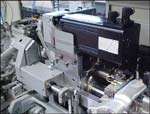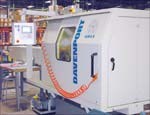Pipe Fittings Produced In A Single Operation
As with many manufacturers today, streamlining production to stay competitive in the global market has become increasingly important at this company. Thatýs why it sought out a machine to produce a double-ended pipe fitting in a single operation as opposed to having to do the back-tapping in an entire second operation.
Anderson Fittings Inc. opened its doors to manufacture brass fittings, valves and accessories for a variety of industries more than 50 years ago in 1947. Since then, the company has steadily grown in its Chicago-area location, expanding its product line to include air brake and pneumatic fittings and employs more than 200 people. "Providing practical and complete fitting and valve solutions with rigorous quality standards—that's how we got to where we are today," says Dan Crapia, director of technical services. "It all comes down to delivering a quality product based on customer budget and scheduling needs."
As with many manufacturers today, streamlining production to stay competitive in the global market has become increasingly important at the company. It had already introduced concepts such as machine cells to its floor, where production of a particular part never leaves a dedicated area of machines. New solutions are still being sought. "We're always looking for new ways to manufacture our parts more efficiently," Mr. Crapia explains. "That's why we wanted to see if we could produce one of our double-ended pipe fittings in a single operation as opposed to having to do the back-tapping in an entire second operation, which was how we were doing it. And that was the capability that we were looking to Davenport for."
Featured Content
Setting The Challenge
Deciding to contact Davenport Machine Inc. (Rochester, New York) about eliminating the second-operation tapping for this part was an easy decision. "We have 22 Davenport machines currently in our shop, two of them being Servo Bs, so the Davenport name was already in our minds," Mr. Crapia explains. "In fact, we had purchased a used Servo B for short, complex runs, and we were very pleased with the machine. Since we knew this part was definitely the right size to fit the Servo Bs' capability, we decided to ask Davenport about this challenge first. As it happens, we never needed to ask anyone else."
After communicating their need directly to Davenport, blueprints for the double-ended fitting were sent for evaluation to Donna Foley, sales engineer and Doug Larson, applications engineer. Larson quickly began to assess the plans. "The first thing we had to determine was if the two-position backworking attachment was robust enough to handle a large tapered pipe tap. Then, we had to establish if there were enough spindle positions to accomplish the job. Only when we were confident that we could do this would we provide a quote for the part. Ultimately, we did and with an estimated cycle time of 11 to 13 seconds per part.
"That's not to say there weren't other challenges involved," Mr. Larson adds. "There was a family of parts quoted for this process, so there was going to be some quick-change tooling involved that had to be taken into consideration in our setup. Plus, we had to have special form drills produced for us to open the taper of the part before we started testing. Eventually, everything came into place."
Proving Its Capability
Once his analysis of the job requirements was completed, Mr. Larson settled on a Davenport Servo B machine with servo burring, hex aligning and two-position backworking to produce the part. "For this process, the servo burring spindle must change speeds five times, change directions twice and stop to eject. Then the spindle must orient to the hex material and slave with the main spindles. The part is cut off when the burring spindle is holding on the hex, after which the spindle changes direction for the first tool to back-drill with a right-hand cut drill. The second tool is then introduced (1/4-18 NPTF), and the burring spindle changes speed to cut the thread in and then changes its direction and speed to back the tap out. Once the tapping is complete, the spindle stops to eject the completed part and synchronizes with the hex material and main spindle speed for the next part," Mr. Larson says.
"What was particularly demanding about this setup was that in order to complete the part in one operation, we had to obtain hex alignment on the burring spindle. We could only accomplish this with servo burring because the spindle had to change direction multiple times during the process."
Mr. Larson's final five-spindle plan provides further details: In the first spindle position, Alloy 360 Brass Round was centered and formed, with the form tool coming in from the side to rough form the outside configuration, and then wrap around the part to face it and hold the overall length. In the second position, the part was drilled halfway through, the outside shaved to the finished dimension, and the inserts polished. The third position completed drilling the part through with the special forming drill ground to a configuration that opened up the taper. The tapping was then completed in the fourth position with a special short projection pipe tap (¼-18 NPTF plus or minus a quarter of a turn). Finally, the backworking was completed in the last position, where the servo burring oriented itself to the hex of the part to hold and cut it off. "The fact that we were able to pick up on the hex shape as well as orient on different shapes was a great advancement for us," Mr. Larson says.
With all of the specifications calculated and tools in place, a 2-hour run-off was scheduled at Davenport's facility. Randy Warren, manufacturing engineer and Davenport setup operators Jerry Huczek, Chris Swider and Edwardo Marquez made the trip from Anderson Fittings to observe the test firsthand. The result: a trouble-free, consistent part run with an average cycle time of 11 seconds per part.
"We were very satisfied with the outcome," Mr. Crapia says. "With the help of Davenport representative Tony Key and NNT Corporation's Dan Monks, distributor representative for Davenport at Anderson Fittings, the purchase was subsequently finalized."
Creating Competitive Efficiency
Anderson Fittings estimates that they've easily saved more than 200 hours annually on setup time alone with the new machine, plus another 600 to 700 hours by eliminating the second operation. "The efficiencies we've gained for the company have been substantial," says Mark Nagengast, business unit manager at Anderson. "We estimate that in two years or less, we'll have earned a complete return on our investment, and that's not including the productivity we've gained."
Along with further savings by eliminating scrap from a second operation, the machine has opened up doors to future opportunities as well. "Now that we are using the Servo B, we have more control over feeds and speeds, and we see an improvement with the rigidity of the machine, we plan on looking into purchasing carbide tooling over high speed, which will improve our machining operation for this part even more."
The company is now in a better competitive position, especially against overseas companies.
RELATED CONTENT
-
Hard Turning as an Alternative to Grinding
Hard turning can be a cost effective alternative for shops looking to streamline part processing.
-
New Line of Swiss-Types for Job Shops Eyeing High-Production Work
Mazak now offers the Syncrex line of Swiss-type CNC lathes — its first — targeting machine shops getting into higher volume production of complex parts.
-
A New Approach to CNC Turning
This turning process takes advantage of a turn-mill’s B-axis spindle to vary a tool’s approach angle to optimize chip control and feed rates.








